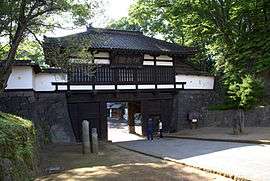Komoro Domain

Komoro Domain (小諸藩 Komoro han) was a feudal domain under the Tokugawa shogunate of Edo period Japan. It is located in Shinano Province, Honshū. The domain was centered at Komoro Castle, located in what is now part of the city of Komoro in Nagano Prefecture.[1]
History
The area which later became Komoro Domain was repeated contested between the Uesugi clan, the Takeda clan and the Late Hōjō clan during the Sengoku period, changing hands repeatedly. After Toyotomi Hideyoshi annihilated the Hōjō clan in the Siege of Odawara in 1590, he awarded Komoro as a 50,000 koku holding to Sengoku Hidehisa. The marked the start of Komoro Domain. He was confirmed in his status by Tokugawa Ieyasu after the Battle of Sekigahara, and his son, Sengoku Tadamasa was transferred to Ueda Domain in 1622.
Komoro was part of the holdings of Kofu Domain from 1622-1624, but was revived as an independent domain for Matsudaira Norinaga from 1624-1647. On his death without an heir, the domain was placed under Matsumoto Domain for a year, until the transfer of Aoyama Munetoshi, who was raised from hatamoto status. He subsequently served as Osaka jōdai from 1662, and Komoro was given to Sakai Tadayoshi, formerly of Isesaki Domain. Sakai was demoted to Tanaka Domain in Suruga Province in 1679. The next ruler of Komoro was Nishio Tadanari, formerly of Tanaka Domain. He made great efforts to undue the damage caused by the misgovernment of Sakai Tadayoshi, but was transferred to Yokosuka Domain in 1682. Komoro was then given to a junior branch of the Matsudaira clan from 1679 to 1702.
In 1702, Makino Yasushige was transferred to Komoro from Yoita Domain in Echigo Province. This at last brought stability to the administration of the domain, as the Makino clan continued to rule until the Meiji restoration.
During the Boshin War, the 10th daimyō, Makino Yasumasu quickly supported the imperial side, and participated in the Battle of Hokuetsu and was assigned to guard Usui Pass. However, in September 1869 he was forced to suppress an attempted coup d’etat within his own domain.
In July 1871, with the abolition of the han system, Komoro Domain briefly became Komoro Prefecture, and was merged into the newly created Nagano Prefecture.
Bakumatsu period holdings
As with most domains in the han system, Komoro Domain consisted of several discontinuous territories calculated to provide the assigned kokudaka, based on periodic cadastral surveys and projected agricultural yields.[2][3]
- Shinano Province
- 16 villages in Chiisagata District
- 46 villages in Saku District
List of daimyo
| # | Name | Tenure | Courtesy title | Court Rank | kokudaka | Notes |
|---|---|---|---|---|---|---|
| 1 | Sengoku Hisahide (仙石秀久) | 1590-1614 | Echizen-no-kami (越前守) | Lower 5th (従五位下) | 50,000 koku | |
| 2 | Sengoku Hidemasa (仙石忠政) | 1614-1622 | Hyōbu-no-daifu (兵部大輔) | Lower 5th (従五位下) | 50,000 koku | transfer to Ueda Domain |
| | ||||||
| 1 | Matsudaira Norinaga (松平憲良) | 1624-1647 | Inaba-no-kami (因幡守) | Lower 5th (従五位下) | 50,000->45,000 koku | from Ogaki Domain |
| | ||||||
| 1 | Aoyama Munetoshi () | 1648-1662 | ’'Inaba-no-kami (因幡守) | Lower 5th (従五位下) | 42,000 koku | transfer to Osaka jodai |
| | ||||||
| 1 | Sakai Tadayoshi (酒井忠能) | 1662-1679 | Hyuga-no-kami (日向守) | Lower 5th (従五位下) | 30,000 ‘'koku | transfer to Tanaka Domain |
| 1 | Nishio Tadanari (西尾忠成) | 1679-1682 | Oki-no-kami (隠岐守) | Lower 5th (従五位下) | 25,000 ‘'koku | transfer to Yokosuka Domain |
| 1 | Matsudaira Norimasa (松平乗政) | 1682-1684 | Mimasakai-no-kami (美作守) | Lower 5th (従五位下) | 20,000 koku | |
| 2 | Matsudaira Noritada (松平乗紀) | 1684-1697 | Noto-no-kami (能登守) | Lower 5th (従五位下) | 20,000 koku | |
| 1 | Makino Yasushige (牧野康重) | 1696-1722 | Suo-no-kami (周防守)) | Lower 5th (従五位下) | 15,000 koku | |
| 2 | Makino Yasuchika (牧野康周) | 1722-1758 | Naizen-no-kami (内膳正) | Lower 5th (従五位下) | 15,000 koku | |
| 3 | Makino Yasumitsu (牧野康満) | 1758-1784 | Totomi-no-kami (遠江守) | Lower 5th (従五位下) | 15,000 koku | |
| 4 | Makino Yasuyori (牧野康陛) | 1784-1794 | Suo-no-kami (周防守) | Lower 5th (従五位下) | 15,000 koku | |
| 5 | Makino Yasutomo (牧野康儔) | 1794-1800 | Naizen-no-kami (内膳正) | Lower 5th (従五位下) | 15,000 koku | |
| 6 | Makino Yasunaga (牧野康長) | 1800-1819 | Naizen-no-kami (内膳正) | Lower 5th (従五位下) | 15,000 koku | |
| 7 | Makino Yasuakira (牧野康明) | 1819-1827 | Suo-no-kami (周防守) | Lower 5th (従五位下) | 15,000 koku | |
| 8 | Makino Yasunori (牧野康命) | 1827-1832 | Totomi-no-kami (遠江守) | Lower 5th (従五位下) | 15,000 koku | |
| 9 | Makino Yasutoshi (牧野康哉) | 1832-1863 | Totomi-no-kami (遠江守) | Lower 5th (従五位下) | 15,000 koku | |
| 10 | Makino Yasumasa (牧野康済) | 1863-1871 | Totomi-no-kami (遠江守) | Lower 5th (従五位下) | 15,000 koku | |
See also
References
- The content of this article was largely derived from that of the corresponding article on Japanese Wikipedia.
- Papinot, E (1910). Historical and Geographic Dictionary of Japan. Tuttle (reprint) 1972.
External links
- (Japanese) Komoro Domain on "Edo 300 HTML"
Notes
- 1 2 3 4 "Shinano Province" at JapaneseCastleExplorer.com; retrieved 2013-5-13.
- ↑ Mass, Jeffrey P. and William B. Hauser. (1987). The Bakufu in Japanese History, p. 150.
- ↑ Elison, George and Bardwell L. Smith (1987). Warlords, Artists, & Commoners: Japan in the Sixteenth Century, p. 18.